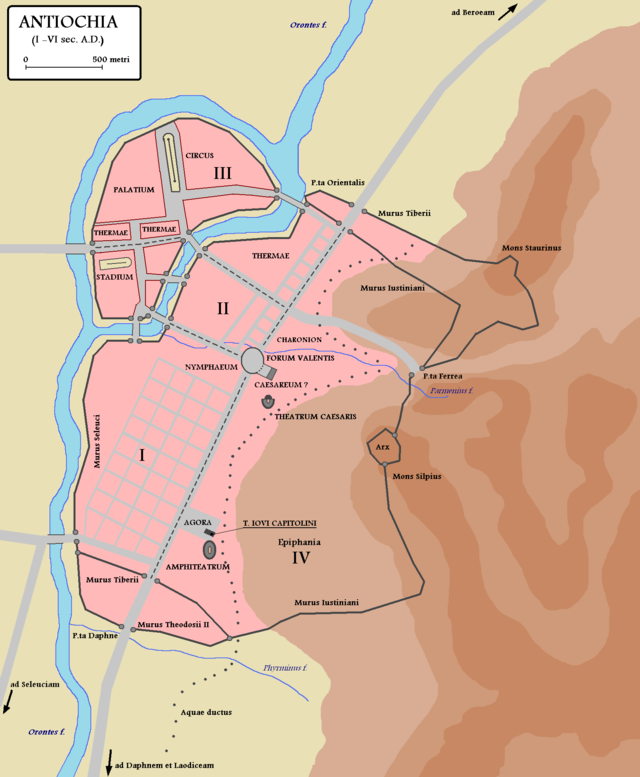Top Qs
Timeline
Chat
Perspective
Siege of Emesa (253)
Siege in Mesopotamia From Wikipedia, the free encyclopedia
Remove ads
The Fall of Emesa of 253 followed a major expedition led by Shapur I (r. 240–270) against the eastern provinces of the Roman Empire in 252–253.[2] The outcome of the siege is debated in the historiography due to contradictory sources, with it being possible that the Persians captured and subdued the city, or that they were driven out by Uranius Antoninus and Odaenathus, with the last one being more probable.
Remove ads
Historical context
Summarize
Perspective
Background

Between 242 and 244, Shapur I (r. 240–270) waged a destructive campaign against the Roman Empire, causing the defeat of the imperial forces under Gordian III (r. 238–244) at the Battle of Misiche in the winter of 244 AD[3] and his eventual assassination by Philip the Arab (r. 244–249) or by officers of his army.[4] All sources say that he then swore friendship or made "the most shameful treaty" with Shapur to end the war.[2][5] In 251/252, according to al Ṭabarī, Shapur again invaded the Roman Empire in the province of Mesopotamia and besieged Nisibis, but serious trouble in the district of Khurasan forced him to march there. Having resolved the trouble in the east, he renewed the siege of Nisibis and the city fell.[6][7] Despite his success, he was unable to continue his conquest of Mesopotamia,[8] which perhaps explains the omission of these operations in his inscription.[9]
Prelude

In 252/253, Shapur took advantage of the chaos that had been established in the Roman Empire at this time.[10] Cyriades, a Roman rebel who would play a role in the subsequent Persian conquest of Antioch,[7][11] probably paved the way for the invaders by causing riots in the eastern provinces, riots apparently mentioned in the Sibylline Oracles. According to it, when the Persians invaded, Antioch was taken, pillaged, deprived of citizens (its population became captives) and destroyed; Hierapolis (modern Manbij), Beroia (modern Aleppo) and Chalcis (modern Qinnasrin) suffered the same fate, before all of Roman Syria and parts of Asia were devastated and pillaged.[12] John Malalas, citing Domninus, alludes to the role of Cyriades in the conquest of Antioch and briefly mentions Shapur's invasion of Syria through Chalcis, which he called the Syrian Gate.[13]

After citing the events of Antioch, Malalas apparently describes the return of the army in which Cyriades was executed and Shapur besieged Emesa (modern Homs), an event apparently alluded to in the Sibylline Oracles and in a Greek graffiti from Calath al-Hawaii.[14][15]
Remove ads
The siege
Summarize
Perspective
Emesa sent Sampsiceramus, whom Rostovtzeff identifies with the Emesan usurper Uranius Antoninus who was active in Syria at the time, as an emissary to Shapur.[16] During his reception, Domninus falsely quotes, the shah was killed in his camp near Emesa, and his fleeing army was pursued, first by Sampsiceramus and then by Odaenathus (here called Enathus).[15][17] The mention of Odaenathus in this episode may be an anticipation of his active participation in the war against Shapur in the 260s, as it may also allude to an active role in the political events in Syria in the previous decade. This would allow us to assume, for example, that Domninus' account has some truth to it. As worked out by Rostovtzeff, it is undoubtedly probable that during his advance up the Euphrates or even before, Shapur entered into negotiations with Odaenathus, who had as his headquarters Palmyra, so as to protect his rear and safeguard abundant supplies of horses, camels, sheep, grain and dates.[18]

In an undated fragment of Peter the Patrician we read an account of gifts sent by Shapur to Odaenathus and scornfully rejected by the shahanshah. For Rostovtzeff, this account reflects negotiations between them and some concessions made by Odaenathus to the shah, concessions which did not satisfy Shapur and were rejected. At the same time, although angry with Odaenathus and perhaps with Sampsiceramus himself mentioned by John Malalas, Shapur did not attack them on their march against Antioch because he knew that Odaenathus was strong. It is possible that he intended revenge if his expedition was successful, and it seems that both Odaenathus and Sampsiceramus were aware that their situation would be endangered if the shah conquered Emesa and Palmyra to the point that they chose to attack him first. Odaenathus may also have expected some compensation from the Romans for his actions, and indeed it is known that by 258 he was in possession of the title of consular man (vir consularis), which he may have received much earlier.[20]
Remove ads
Notes
References
Sources
Wikiwand - on
Seamless Wikipedia browsing. On steroids.
Remove ads